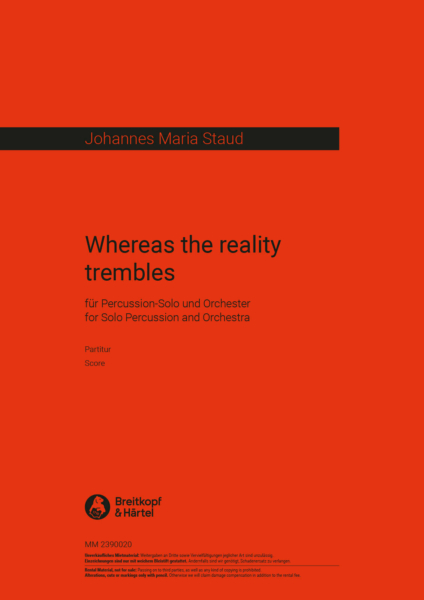Johannes Maria Staud (*1974) Whereas the reality trembles
[Schl,Orch] 2022 Dauer: 21'
3.3.3.3 – 4.3.2.1 – Klav – Pk – Schl(3) – Str: 14.12.10.8.6
Uraufführung: Cleveland/USA, 5. Oktober 2023
Auftragswerk des Cleveland Orchestra, des Wiener Konzerthauses und des Orchesters des Bayerischen Rundfunks
Der Titel des neuen Schlagzeugkonzerts von Johannes Maria Staud, Whereas the reality trembles, kam dem Komponisten in seinem Kompositionsprozess erst spät in den Sinn, als bleibende Wirkung des langen Eintauchens in die Werke des amerikanischen Dichters William Carlos Williams während seiner Abgeschiedenheit durch die Pandemie. Staud hatte kurz zuvor zwei andere Werke geschrieben, die von Williams' Texten inspiriert waren, und fand, dass der Satz ihm genau das zeigte, was er von einem Schlagzeugkonzert erwartete.
„Williams spricht oft davon, dass die Realität ein wenig schillernd ist; [sein Werk] ist sehr vom Raum zwischen den Ereignissen besessen“, sagt Staud, der 2022 mit dem Österreichischen Kunstpreis ausgezeichnet wurde und sich in seinem zweieinhalb Jahrzehnte währenden Schaffen oft von Literatur und bildender Kunst inspirieren ließ. „Was ist Realität? Ist es das Orchester, ist es das Schlagzeug, ist es das politische Umfeld, in dem ich heute Musik mache? Für mich ist dies ein poetischer Raum, in dem ich mich frei fühle, Musik auf einer sehr spielerischen Ebene zu erfinden.“
Wie bei der Poesie selbst beginnen Bedeutungsebenen, sich zu entfalten, wenn wir über seinen Arbeitsprozess und die Zusammenarbeit mit Christoph Sietzen sprechen, dem Schlagzeuger, der 2023 die Weltpremiere von Whereas the reality trembles mit dem Cleveland Orchestra aufführen wird. Eine schillernde Realität — eine, die fest erscheint, aber nicht fixiert ist und in den Zwischenräumen pures Potenzial birgt — fängt die Dualität, die Dynamik und den molekular vibrierenden Prozess ein, die alle der Entstehung von Stauds neuestem Stück zugrunde liegen.
In Sietzen hat er den perfekten Partner gefunden, einen Künstler, dessen rohe Energie auf der Bühne in Aufführungen von fesselnder und herausfordernd raffinierter Kunstfertigkeit explodiert. Wenn man den Komponisten und den Ausführenden über die Entstehung eines Schlagzeugwerkes sprechen hört, kann man nicht anders, als sich eine Menge Spiel vorzustellen. Blumentöpfe, Metalltrommeln, Kuhglocken, Trödelpercussion — die Möglichkeiten des Klangs und der Gegenstände, die Klänge erzeugen können, sind unendlich. Wo soll man da anfangen?
Beide sagen, dass mit der Wahl der Instrumente, die durch den Austausch von Ideen und Erfahrungsschnipseln geprägt ist, Fragen und weitere Ideen und Experimente ausgelöst werden. Das Schlagzeugkonzert beginnt mit Marimba und Kuhglocken, eine Kombination, die Sietzen aus einem früheren Werk kannte und Staud vorschlug. Den Komponisten, dessen Musik ein eigenes klangliches Ökosystem schafft — lebendig, vielschichtig, strukturiert, melodiös, voller Farben und Überraschungen —, interessiert die Kombination von Klängen, nicht ein Objekt oder ein Klang für sich allein.
Staud fand Gefallen an der Kombination von Metall und Holz; das Solo-Schlagzeug des neuen Konzerts besteht aus mehr als zwei Oktaven gestimmter Kuhglocken, verschiedenen Holzblöcken, Mokushos und Holzkisten, einem Metallfass, das mit einem Fußpedal gespielt wird, sowie Metalldosen und Kanistern. (Die Tatsache, dass Kuhglocken nie ganz richtig gestimmt sind, gefällt Sietzen: „Sie sind nie hundertprozentig in der Tonhöhe, das ergibt diese leichte Unvollkommenheit, die es eigentlich erst richtig interessant macht.“) Staud mag es auch, „High-Tech- und Low-Tech-Instrumente“ zu kombinieren – das Metallfass zum Beispiel hat einen etwas „trashigeren Klang“, sagt er. „Das gefällt mir sehr gut.“ Auch Blumentöpfe sind eine weitere Anregung von Sietzen. Kurz vor unserem Gespräch hatten Komponist und Ausführender darüber diskutiert, wie man härtere Blumentöpfe finden könnte, die bei kräftigen Schlägen nicht zerbrechen.
Das Schlagzeuginstrumentarium ist eine eigene schillernde Realität. Seit dem Altertum haben Menschen in Kulturen auf der ganzen Welt auf Gegenstände — von Kürbissen und Stöcken bis hin zu Trommeln und Log-Xylophonen — geschlagen, sie geschüttelt, gekratzt und zusammengebastelt, um als Teil von Ritualen und zur Unterhaltung Rhythmus, Klang und Melodien zu erzeugen.
„Was wir heute als ‚Percussion‘ kennen, wurde entweder im 20. Jahrhundert entwickelt oder in verschiedenen ethnomusikologischen Kontexten gefunden und auf sehr reiche, konstruktive und bunte Weise zusammengemischt. Das ist keine kulturelle Aneignung, sondern Neugierde, tiefer Respekt und gegenseitige Inspiration zwischen verschiedenen Hintergründen“, so Staud. „Es ist unser Ziel, diesem ‚Instrumentarium‘ im 21. Jahrhundert eine echte Bedeutung zu geben und viele Werke dafür zu komponieren.“
Ein Wendepunkt in der westlichen Musik für Schlagzeug kam im 20. Jahrhundert mit bahnbrechenden Werken wie Edgard Varèses Ionisation für 13 Schlagzeuger (1929) und Béla Bartóks Sonate für zwei Klaviere und Schlagzeug (1937). In der Folge entstanden zahlreiche grenzüberschreitende Kompositionen, angeführt von den Schlagzeugpionieren John Cage und Iannis Xenakis, deren Erfindungsreichtum in der Klanggestaltung eine völlig neue Welt der akustischen Wahrnehmung und der klanglichen Möglichkeiten eröffnete.
„Die Komponisten begannen, das Schlagzeug zu entdecken“, sagt Sietzen, „und ich denke, dass es in der Musik unserer Zeit ein sehr wichtiges Instrument ist.“
Whereas the reality trembles kommt also zu einem Zeitpunkt, der reif ist für den Schlagzeugkanon. Staud, ein ehemaliger Stipendiat des Cleveland Orchestra, dessen Œuvre Orchester-, Ensemble- und Solowerke mit und ohne Elektronik umfasst, stellt fest, dass sich mit großen Solisten die Möglichkeit bietet, neue Konzerte mit gewagten Klangwelten zu schaffen. Es war ein Glücksfall, Sietzen für diesen gemeinsamen Auftrag von Cleveland, dem Wiener Konzerthaus und dem Symphonieorchester des Bayerischen Rundfunks zu gewinnen. „Er ist ein sehr tiefgründiger Künstler“, sagt Staud. „Er ist besessen von gutem Klang und guten Instrumenten. Es ist sehr einfach mit ihm.“
Als Interpret sagt Sietzen, dass sein Wille, zum Kern der Absichten des Komponisten vorzudringen, den Prozess seiner Zusammenarbeit leitet. Die Herangehensweisen sind sehr unterschiedlich: Eine Komposition kann sich nur auf gestimmte Instrumente konzentrieren, bei einer anderen kann es sein, dass er Schrott vom Schrottplatz holt (wie er es bei Georg Friedrich Haas' Konzert für Klangwerk und Orchester, das 2019 uraufgeführt wurde, ausgiebig getan hat).
„Jedes neue Schlagzeugkonzert ist etwas Besonderes, weil es in der Regel eine neue Herangehensweise gibt; jeder Komponist versucht, etwas zu schaffen, was es vorher noch nicht gegeben hat“, sagt Sietzen.
Letztendlich ist der strenge und unerbittliche Prozess des Auswählens, Ausprobierens, Experimentierens und Konstruierens vielleicht nur hinter den Kulissen wahrnehmbar. Sietzen verfügt über die ausgeprägte Fähigkeit, mit seinen Schlaginstrumenten zu verschmelzen und etwas jenseits von Rhythmus und Melodie freizusetzen — eine Verschmelzung von Klang, reiner Energie außergewöhnlicher Raffinesse, die sich in pure Begeisterung und Freude steigert. Es ist eine Perfektion aus Millionen Nuancen, eine schimmernde Realität für sich.
(Luna Shyr, Februar 2023)
Ursprünglich geschrieben als „Christoph Sietzen und Johannes Maria Staud betreten Neuland in Whereas the reality trembles, einem Konzert für Schlagzeug“ für The Cleveland Orchestra anlässlich der Uraufführung und der Nachfolgeaufführungen von Whereas the reality trembles. Nachdruck mit Genehmigung der Autorin.










 Blättern
Blättern